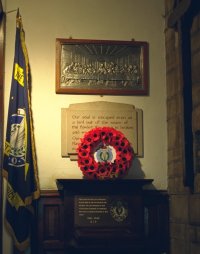
|
The LAA memorial
 Just fifty years ago, in May 1949, the memorial to members of the
35th Light
Anti-Aircraft Regiment (Royal Artillery) was dedicated. This memorial is in the little
corner to the right of the door under the organ case. It is associated with the memorial
to the Far East Prisoners of War, many of whom were members of the 35th LAA - this was
formed in 1940 with a high proportion of Nottinghamshire men. The regiment was sent to
Singapore only a few months before the surrender of the colony to the Japanese, and only
40% of the regiment survived the war.
Just fifty years ago, in May 1949, the memorial to members of the
35th Light
Anti-Aircraft Regiment (Royal Artillery) was dedicated. This memorial is in the little
corner to the right of the door under the organ case. It is associated with the memorial
to the Far East Prisoners of War, many of whom were members of the 35th LAA - this was
formed in 1940 with a high proportion of Nottinghamshire men. The regiment was sent to
Singapore only a few months before the surrender of the colony to the Japanese, and only
40% of the regiment survived the war.
The LAA memorial has two parts. Above a glass case containing the regimental Roll of Honour, there is a marble plaque with an inscription from Psalm 124:
Our soul is escaped even as
a bird out of the snare of
the fowler: the snare is broken
and we are delivered.
Our help standeth in the
Name of the Lord: who hath
made heaven and earth.
In 1985 the FEPOW Association gave the silver "Last Supper" which stands above the plaque, and later their standard was "laid up" in the church - the flag now stands beside the memorial.
An interesting document has recently come to light which explains the LAA memorial and why it is in St Peter’s. Mrs Olive Hardy was a very long-standing member of St Peter’s congregation, who emigrated to Australia in her 90s and died there last January at the age of 98. Her husband Jack had been among the members of the LAA captured by the Japanese (and died in captivity). Olive was one of the prime movers of the Relatives Association set up in Nottingham in 1944, which kept families in touch with one other, exchanged news and provided support both for the families and for the soldiers who returned. She had kept the official minute book of the Relatives Association, which has now been sent to St Peter’s by her daughters. (The minute book has been deposited in the Nottinghamshire Archives Office, where it can be consulted along with St Peter’s parish records.)
St Peter’s came into the picture in September 1947, when the committee decided to place a memorial tablet in one of the city churches. St Peter’s may have been chosen because of Olive Hardy’s connection or for some other reason; but the Rector, the Revd. Arnold Lee, welcomed the idea - shortly before he left St Peter’s to move to Gedling! There was of course (as we know all too well at the moment) an interregnum before a new Rector arrived, and the minutes for September 1948 note that "the church still has no vicar and it is customary for the incumbent to sanction such things". But the diocesan authorities in Southwell gave helpful advice and Allan Derry, as churchwarden, was involved in liaising with the committee; and a suitable stone was prepared by the memorial department of the Nottingham Co-operative Society.
By October 1948 the Rev. Angus Inglis, a former Army Chaplain, had been appointed Rector - and soon set about revising the plans! The idea of a book of remembrance came from him, and he insisted that the lettering could not be done locally, at the College of Art, but should be sent to London. He also, I suspect, adjusted the wording on the plaque to its present elegant simplicity (the diocese had asked for changes to the style of numerals - but no numerals now appear).
Furthermore, his contacts proved useful when it came to dedicating the plaque: "Mr Inglis has contacted the Bishop of Singapore who is now on his way home" (the Rt. Rev. J. Leslie Wilson had also been a prisoner of war). And after farther discussion of whether to invite the Lord Mayor (it was decided not to, to avoid making it a public occasion) the dedication service was held on 22 May, with Bishop Wilson unveiling the plaque. Tea and refreshments were served in the "mission room adjoining the church" - presumably the St James’s Room - and another part of St Peter’s history was in place.
Return to the History contents page
http://www.stpetersnottingham.org/history/laa.html
© St Peter's Church, Nottingham
Last revised 30th April 1999